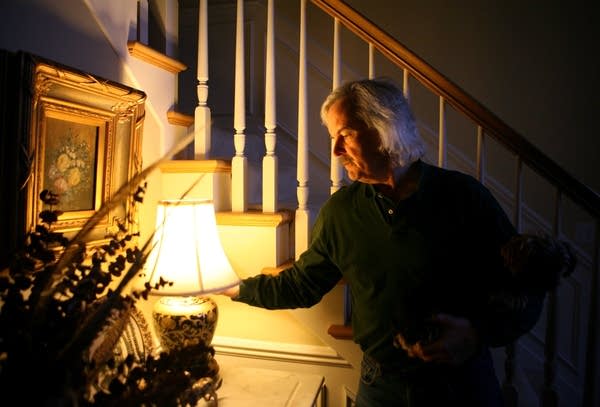Would a cap and trade system burden Minnesota?

John Whaley says he's been a conservationist all his life.
"I think it started when I saw movie or something in high school, about the war effort: people were crushing cans and recycling," Whaley said. "And I said to my dad, 'Why don't they do that anymore?' And he looked at me and he goes, 'I don't really know, we should.' "
Back in those days, young John Whaley had to take his recycled cans to a scrap yard. Now, they're picked up at the curb.
A few years ago, Whaley bought a house in a new subdivision in Eden Prairie, close to where he works. He made sure the insulation was thick and the windows were tight.
Create a More Connected Minnesota
MPR News is your trusted resource for the news you need. With your support, MPR News brings accessible, courageous journalism and authentic conversation to everyone - free of paywalls and barriers. Your gift makes a difference.
Whaley said he worked for years to get the family -- his wife and two grown sons -- to take shorter showers. Recently, they installed solar lighting in the back yard, and they use the sun to warm the house.
"On the south side of the house in the wintertime, we open up the blinds and let solar gain in, and it almost heats the house during the day," he said. "At night, we shut everything down. Again that's just a habit that doesn't cost any money."
Experts say we can cut down on energy use by 20 to 30 percent just through conservation.
Outside, to get his neighbors interested, John Whaley installed solar lights on the pillars that mark the entrance to the subdivision.
"We just mounted a little solar collector there, each one comes with four lights, so we illuminated these little neighborhood markers," he said. "It's beautiful at night, and it doesn't cost a dime."
Carbon reduction = major economic reconstruction
More and more of us might be making such simple changes as we move toward a post-carbon world. That's the idea behind this week's meetings in Copenhagen, and the idea behind legislation proposed in Congress.
President Barack Obama says the goal for the U.S. will be to cut our greenhouse gas emissions by 17 percent by 2020, and 83 percent by 2050. That's essentially the same goal envisioned in the American Clean Energy and Security Act, passed by the House last June, and in bills the Senate is expected to take up this spring.

University of Minnesota economics professor Steve Polasky said that amount of carbon reduction would require a major restructuring of the economy. But, he said it's certainly possible to do.
"If you have 30 or 40 years in which to build new infrastructure, knowing that the price of carbon is going to be important in that, you build infrastructure with that in mind," Polasky said. "It'll be far cheaper than trying to retrofit things or doing an emergency program today,"
Supporters of a cap and trade system see it as an efficient and market-friendly way to move society toward the goal of cutting emissions.
What is cap and trade?
In a cap and trade system, companies that emit a lot of carbon dioxide would have to have allowances (permits) for each ton of carbon dioxide they emit.
At first, most of the allowances would be given to electric companies, natural gas companies, and some industries that use a lot of energy. The utilities would be instructed to pass the value of the allowances on to their customers, or to help customers invest in energy-saving measures like insulation or a new furnace. So for the first 10 years at least, Polasky said energy prices would go up, but not dramatically.
"In the near term, we're not actually changing the energy supply that drastically," he said. "And also we're cushioning the blow to consumers somewhat by doing things like handing out the permits to electric utility producers for free."
Over time, the utilities would have to pay for the allowances, and the number of allowances would shrink. So, they'd be forced to find ways other than burning coal to generate electricity.
That's what Xcel Energy has done at its High Bridge plant in downtown St. Paul. Xcel converted the plant from coal to natural gas, cutting greenhouse gas emissions in half.
Utilities are also investing in wind power, and they're talking about building more nuclear plants. They're also trying to figure out if they can capture the carbon dioxide from coal-fired power plants and store it underground.
Conservative groups take issue
Either way, the cost of energy is expected to go up.
Some of the money from sales of allowances would be rebated back to families to help them cope with the higher prices. The government would also invest in research to develop new forms of energy.
Conservative groups, including the Heritage Foundation, the U.S. Chamber of Commerce, and the National Association of Manufacturers, say the global warming legislation being considered in Congress would kill jobs and raise energy prices too much.
The non-partisan Congressional Budget Office says the costs would be modest, perhaps 3 percent in an economy that 40 years from now will be two-and-a-half times as large as it is today.
So what does this mean for purchasing power, say at the grocery store?
The CBO says the average household would lose $90 dollars a year in purchasing power in 2012 and $925 dollars a year in 2050. Of course, climate change itself could be costly -- especially to certain sectors of the economy, like agriculture.
Benefits of cap and trade
But would the cap-and-trade system do the job? Would it be powerful enough to reduce greenhouse gas emissions enough to prevent the worst disruptions that climate scientists predict?
J. Drake Hamilton, science Policy Director with Fresh Energy, a Minnesota group advocating government action on global warming, said raising the cost of fossil fuels would push businesses to invest in low-carbon technologies.
"What's missing now is the price signal that says, 'We're really, seriously moving to a low carbon economy and you're going to make money off of low-carbon technologies,'" Hamilton said. That, said Hamilton, would open the floodgates of American ingenuity, and keep energy costs low, even as we move into a new, post-carbon energy world.
That's what John Whaley, back in Eden Prairie, is hoping for. He said as a conservative -- he's a Republican -- it only makes sense to conserve limited assets.
"Petro energy is finite, it's going to go away, it pollutes," Whaley said. "We need to find wind, solar solutions that are cost-effective. We've seen some progress, but I'd like to see it happen a lot faster."
And supporters say a cap and trade system would speed progress, with minimal pain for ordinary families like the Whaleys.


